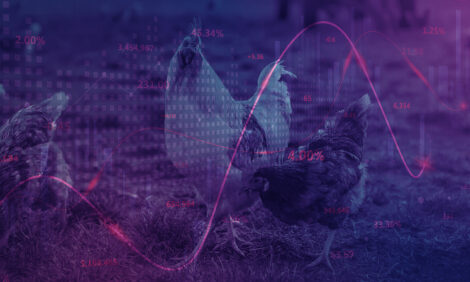



Weekly global protein digest: US egg prices retreat sharply from highs amid bird flu recovery
Livestock analyst Jim Wyckoff reports on global protein newsWeekly USDA US beef, pork export sales
Beef: Net sales of 14,600 MT for 2025 were up 91 percent from the previous week and 21 percent from the prior 4-week average. Increases were primarily for South Korea (4,500 MT, including decreases of 400 MT), Japan (3,400 MT, including decreases of 200 MT), Mexico (2,600 MT), Taiwan (1,400 MT), and Canada (1,200 MT). Exports of 13,600 MT were down 10 percent from the previous week and 7 percent from the prior 4-week average. The destinations were primarily to South Korea (4,800 MT), Japan (3,900 MT), Mexico (1,500 MT), Taiwan (1,300 MT), and Hong Kong (900 MT).
Pork: Net sales of 24,600 MT for 2025 were up 2 percent from the previous week and 16 percent from the prior 4-week average. Increases were primarily for Mexico (10,600 MT, including decreases of 200 MT), Japan (3,500 MT, including decreases of 200 MT), Canada (2,800 MT), Colombia (2,300 MT, including decreases of 100 MT), and Chile (1,000 MT). Exports of 26,500 MT were up 4 percent from the previous week, but down 3 percent from the prior 4-week average. The destinations were primarily to Mexico (12,000 MT), Japan (4,100 MT), South Korea (3,100 MT), Colombia (1,800 MT), and Canada (1,300 MT).
U.S. choice grade boxed beef value tops $350
US wholesale choice beef prices firmed $1.96 to $350.10 on Tuesday, topping that level for only the second time. Still, packer margins remain deep in the red – the worst in 10 years – as wholesale beef price strength hasn’t kept pace with surging cash cattle prices.
JBS, the world’s largest meatpacker, reports 78% year-over-year increase in Q1 net profit
JBS profits reached 2.92 billion Brazilian reais ($521 million) — buoyed by robust performance in its Brazilian and U.S. poultry and pork operations. Despite global tariff tensions, CEO Gilberto Tomazoni said the impact on operations remains “insignificant.”
“Quarter after quarter, our results prove that we made the right choices in building and managing our global multi-protein platform,” Tomazoni stated.
Key Financial Highlights
- Net profit: 2.92 billion reais, up from 1.64 billion reais a year earlier
- EBITDA: 8.92 billion reais, beating analyst estimates of 8.77 billion
- Net revenue: 114.1 billion reais, +28% YoY, but -2.2% QoQ
- Profit growth from Q4: +21.2%
The company saw record EBITDA margins in Brazil's Seara processed foods division and in U.S.-based Pilgrim’s Pride.
Segment Performance & Trade Exposure
- North America beef division posted a 37.5 billion reais revenue (up 36% YoY) but suffered an operating loss of 587.2 million reais due to U.S. cattle shortages.
- Rising cattle costs in both Brazil and the U.S. pose future margin risks.
- China accounted for 23% of JBS’s $4.9 billion in exports last quarter.
CEO Tomazoni dismissed short-term concerns over potential oversupply of pork and chicken in the U.S.
Outlook: JBS is nearing a major milestone: a planned listing on the New York Stock Exchange, expected next month pending shareholder approval within 10 days.
US consumer price index trends: February–April
CPI from February through April showed a continued moderation in overall inflation, with food prices declining and energy prices rising modestly in April. It was the third-straight month U.S. gov’t inflation numbers were lower than forecast.
Monthly Changes (April):
- The food index fell 0.1% overall in April.
- "Food at home" fell 0.4% MoM.
- Notable declines: eggs (-12.7% MoM), pork (-1.4%), fats and oils (-1.5%), fresh fruits (-0.4%), fresh vegetables (-0.1%). Egg prices fell by the biggest monthly decline since 1984. And they could continue to fall this month, too: USDA reported last week that a dozen large white-shell eggs now cost $3.30 on average, down 69 cents from a week before. Nevertheless, egg prices remain significantly higher now than before the latest bird flu outbreak, and they cost 49.3% more last month than they did a year earlier. Eggs are still more expensive than when Trump took office, according to the BLS.
- Some increases: beef and veal (+0.1%), poultry (+0.2%), fish and seafood (+0.7%), coffee and tea (+2.0%).
Trend: Food price inflation is cooling, with grocery prices (food at home) actually declining in April after being flat or rising modestly in previous months.
US egg prices retreat sharply from highs amid bird flu recovery
April saw 18% price drop as supply chains stabilize and panic-buying eases
Egg prices fell significantly in April, offering welcome relief to consumers after months of record highs driven by avian flu disruptions. Shoppers paid an average of $5.122 per dozen, down 18% from over $6 in February and March, according to the U.S. Bureau of Labor Statistics. This marked the largest monthly drop in the egg price index since 1984, helping to moderate the broader U.S. inflation data for April.
Supply rebounds, Easter demand steady
The decline came even during the Easter holiday, traditionally a strong period for egg demand. Analysts say panic-buying subsided and avian flu outbreaks slowed, allowing retailers to replenish shelves. Justin Barlup of Bloomberg Green Markets noted that sales during the holiday were on par with previous years and predicted further price declines into summer, when demand typically weakens.
Wholesale prices stabilize, but retail still elevated
Retailers have been slow to mirror wholesale price declines, citing caution amid continued supply risks. A late-April bird flu outbreak in South Dakota affected over 630,000 birds, keeping upward pressure on wholesale prices and tempering retailer discounts. USDA noted grocers have mostly avoided putting eggs on sale.
Tariffs add upward pressure
Vital Farms plans a low double-digit price increase for shell eggs at Target and Whole Foods, citing new Trump administration tariffs and rising input costs. CEO Russell Diez-Canseco told Bloomberg that tariffs have made modest hikes “prudent” to maintain supply commitments.
Import surge and production outlook
USDA expects U.S. egg imports to nearly triple in 2025 to 103.7 million dozen, with President Trump’s administration touting the move as part of its inflation-fighting strategy. U.S. egg production is forecast to rise 6% in 2026 — the first increase in three years — to 9.32 billion dozen. Prices are projected to fall to $2.16 per dozen next year.
Industry response
Higher prices are drawing fresh investment. Global Eggs, which recently acquired Hillandale Farms, plans to expand flocks by 5% in 2025, CEO Ricardo Faria said.
Bottom Line: Prices are easing but remain historically high, with tariffs, biosecurity risks, and retailer caution keeping eggs elevated for now — even as imports and production surge.
US suspends Mexican live animal imports over screwworm threat
USDA Secretary Brooke Rollins on Sunday announced the suspension of live cattle, horse and bison imports through ports of entry along the U.S./Mexico border in response to the rapid northward advance of the New World Screwworm (NWS) in Mexico. The ban comes as new detections were confirmed as far north as Oaxaca and Veracruz — just 700 miles from the U.S. border. Despite joint eradication efforts with Mexico, Rollins called the screwworm’s continued spread “unacceptable” and said the move is necessary to protect U.S. livestock and national food security. USDA is deploying Tick Riders – horse-mounted patrol inspectors – to monitor livestock and wildlife along the southern border for signs of infestation. Mexican Ag Minister Julio Berdegue swiftly rebuked the action, but said he hoped the two countries could soon come to an agreement over the pest.
Brazil’s beef exports to the US in April surge despite new tariffs
U.S. imports of Brazilian beef hit record highs amid domestic supply shortages
Brazil’s beef exports to the United States soared in April 2025, with 48,000 metric tons (MT) shipped despite the recent enforcement of a 10% tariff on Brazilian beef. This figure marks a dramatic increase compared to the roughly 8,000 MT exported in April 2024, surprising even industry leaders.
Key drivers behind the surge
- U.S. cattle shortage: A significant shortage of cattle in the U.S. has driven up demand for imported beef, particularly from Brazil and Australia.
- Tariff changes: Previously, Brazilian beef exceeding the annual quota of 65,000 MT faced a 26.4% tariff in the U.S. The new policy now imposes an additional 10% tariff on all Brazilian beef, including sales within the quota, which previously entered tariff-free.
- Quota filled early: The annual 65,000 MT low-tariff quota was filled as early as January, meaning subsequent exports faced the full tariff burden.
Market impact and industry response
- Resilient demand: Despite the added costs from tariffs, demand for Brazilian beef in the U.S. remains robust. Industry experts believe that the market can absorb the extra costs, especially given historically low U.S. beef stocks and persistent supply shortages.
- Competitive edge: Brazil’s large-scale production and cost efficiencies continue to make its beef competitive, even with higher tariffs.
- Global expansion: While the U.S. is a key market, China remains the largest importer of Brazilian beef. In 2024, China imported around 1.33 million tons, while the U.S. imported 229,000 tons, highlighting Brazil’s growing global reach.
Outlook for 2025
- Record exports expected: USDA forecasts Brazil’s beef exports to grow by another 3% in 2025, reaching a new record of 3.75 million tons, driven by strong demand from major partners including the U.S., Chile, and the Philippines.
- Industry optimism: Brazilian exporters remain optimistic, aiming to expand their market share in both the U.S. and other regions, despite the evolving tariff landscape.
Quote of note: “It was a historic year for the national beef industry, for the livestock sector and for Brazil. The decisive contribution to the positive trade balance is proof of this, and was already expected.” — Roberto Perosa, President of the Brazilian Association of Meat Exporting Industries (Abiec).
China’s meat imports decline in April 2025
Sharp Drop in Meat Imports Reflects Broader Economic and Trade Shifts
China’s meat imports saw a notable decline in April 2025, continuing a downward trend that has developed over recent months. In April, China imported 513,000 metric tons (MT) of meat, a drop of 35,000 MT (6.4%) from March and 31,000 MT (5.7%) less than April 2024. For the first four months of 2025, total meat imports reached 2.16 million metric tons (MMT), down 64,000 MT (2.9%) compared to the same period last year.
Key drivers behind the decline
- Economic headwinds: Slower economic growth and softer consumer demand are reducing the appetite for imported meat, particularly after the Lunar New Year festivities.
- Domestic supply: China has built up ample domestic meat stocks, especially pork, which has reduced the need for imports.
- Trade frictions: Ongoing trade tensions, especially with the U.S., have led to regulatory disruptions and uncertainty for importers. Expiring U.S. plant licenses and high tariffs have further complicated trade flows.
- Currency pressures: The depreciation of the yuan against the U.S. dollar has made imports more expensive, impacting demand for foreign meat products.
- Shifts in consumer behavior: Chinese consumers are increasingly price-sensitive, favoring cheaper protein sources and lower-cost imports, particularly from South America for beef.
Sector-specific trends
- Beef: While beef imports are projected to grow slightly in 2025 due to declining domestic production, the growth rate is expected to slow, with a preference for lower-cost South American beef over more expensive alternatives.
- Poultry: Chicken imports are forecast to fall sharply in 2025 as domestic output rises and disease-related trade restrictions persist. Brazil remains the dominant supplier, but overall volumes are down.
- Pork: Pork imports may see marginal growth to offset a forecasted decline in domestic production, but overall demand remains subdued due to high domestic output and economic pressures.
Outlook: The decline in China’s meat imports is expected to persist as domestic production remains strong, economic challenges continue, and trade uncertainties linger. This trend is reshaping global meat trade flows, prompting major exporters like the U.S., Brazil, and Australia to adjust their strategies in response to changing Chinese demand.
Weekly USDA dairy report
CME GROUP CASH MARKETS (5/9) BUTTER: Grade AA closed at $2.3300. The weekly average for Grade AA is $2.3305 (+0.0405). CHEESE: Barrels closed at $1.7700 and 40# blocks at $1.8175. The weekly average for barrels is $1.7870 (+0.0675) and blocks $1.8075 (+0.0745). NONFAT DRY MILK: Grade A closed at $1.2075. The weekly average for Grade A is $1.2060 (+0.0210). DRY WHEY: Extra grade dry whey closed at $0.5425. The weekly average for dry whey is $0.5360 (+0.0300).
BUTTER HIGHLIGHTS: Domestic retail butter demand varies from steady to strong throughout the country. Some sellers describe domestic food service demand as weaker compared to this time last year. Export demand is strong. Cream volumes for butter manufacturers are more than ample despite some seasonal production upticks for certain dairy commodities. Butter production is strong. Butter inventories are generally growing to various degrees. Bulk butter overages range from 5 cents below to 5 cents above market across all regions.
CHEESE HIGHLIGHTS: Contacts in the East region share strong milk availability is allowing cheese processors to run increased production schedules. Contacts continue to note cheese demand and sales have slowed with increased milk production; cheese inventories are growing. The Central region cheese contacts report mixed spot demand. Spot cheese inventories are less tight. Spot milk prices range reported as low as -$5 under Class III at reporting time. Contacts in the West region also share cheese production schedules are steady for the most part. Inventories available to spot load buyers are extremely tight for cheese producers. Domestic prices are holding some competitiveness against international prices.
FLUID MILK HIGHLIGHTS: Milk production is generally strong nationwide. Spring flush continues in the Northern part of the country, while in other areas, milk production remains in good balance with demand. Milk for Class I remains steady but manufacturers expect a slowdown of production as the Spring school semester winds down. Class II production is trending up as more cream is allocated toward ice cream and frozen dairy mixes. Milk for Class III is growing this week. Cheese production is up to account for the spring flush in the Midwest and Northeast. Cream production remains strong nationwide. Butter churns are still operating at or near capacity. Spot loads for cream are available and the multiples range increased. Condensed skim is available with demands varying from steady to lighter. Cream Multiples for All Classes range: 1.05 – 1.25 in the East; 1.10 – 1.25 in the Central; and 0.95 – 1.18 in the West.
DRY PRODUCTS HIGHLIGHTS: Low/medium heat nonfat dry milk (NDM) prices moved higher across the range and mostly price series in all regions this week. Contacts report demand for low/medium heat NDM is strengthening. High heat NDM prices increased in the Central and East regions but moved lower in the West. The Central and East dry buttermilk price range moved lower at the bottom, while the top held steady. The West dry buttermilk price range increased at the bottom but decreased at the top. The West dry buttermilk mostly price series was unchanged. [LC1] Dry whey prices increased in the Central region, held steady in the West, and moved lower in the East. Prices for whey protein concentrate 34% (WPC 34%) moved higher across the range and mostly price series amid light production and tight inventories. Lactose prices moved lower at the top of the range and mostly price series this week. Prices for dry whole milk, acid casein, and rennet casein were unchanged in week 19.
INTERNATIONAL DAIRY MARKET NEWS:
WEST EUROPE: The UK-based Agriculture and Horticulture Development Board (AHDB) released data showing daily milk deliveries for the week ending April 26th, averaged 38.38 million liters, up 0.8 percent from the week prior and up 6.1 percent from the same week last year. The UK average farm-gate milk price for March 2025 is listed at 46.01 pence per liter, down 0.2 percent from February 2025, but up 18 percent from March 2024.
EAST EUROPE: No new cases of foot and mouth disease (FMD) have been confirmed. The UK continues a ban on personal meat and dairy imports from the EU after travel to prevent possible introduction of foot and mouth disease. OCEANIA: AUSTRALIA: A large Australian dairy product manufacturer announced it is closing a Victoria cheese plant in an attempt to consolidate redundant manufacturing lines. Following announcements from two processors in Australia, a third recently announced a 10¢/kgMS increase in 2024/2025 farmgate milk prices.
NEW ZEALAND: Milk production data from New Zealand for March 2025 was recently released. This data showed total March 2025 production was 1.76 million metric tons, up 0.6 compared to a year earlier. During March 2025, total milk solids increased by 0.8 percent to 174.0 million kg from the previous year.
SOUTH AMERICA: Uruguay stakeholders note milder weather than anticipated is contributing positively to milk production. However, some contacts convey milk yields from dairy farmers are down from last year. Handlers describe feed costs for dairy farmers as very affordable.
US NATIONAL RETAIL REPORT: Total conventional dairy ads increased by 1 percent in the Week 19 retail survey, while organic dairy ads declined 17 percent. Cheese is the most advertised conventional dairy commodity this week, while milk is the most advertised organic dairy commodity. Ice cream remains the second most advertised conventional dairy commodity this week. Total ads for conventional milk increased 1 percent this week and organic milk ads were up 18 percent. The organic premium for a half gallon organic milk is $3.01.









